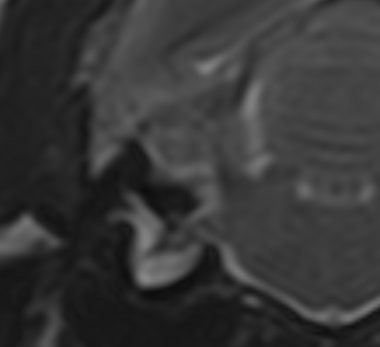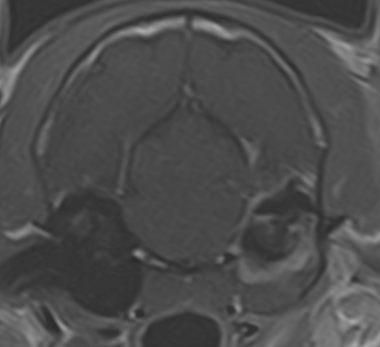Web-Vet TM Neurology Specialists



Vestibular Dysfunction
Head tilt is indicative of vestibular disease and is the most consistent sign of a unilateral vestibular deficit. Nystagmus is a term used to denote the involuntary rhythmic oscillation of the eyeballs; the eye movements have a slow phase in one direction and a rapid recovery in the opposite direction, which can be horizontal, rotary, or vertical in character.
Other clinical signs of vestibular dysfunction include ataxia, a wide-based stance, circling, leaning, falling, or rolling toward the side of the head tilt, and positional strabismus, where the eye on the affected side deviates ventrally or ventrolaterally when the head is elevated. Animals with acute vestibular disease can present with anorexia or vomiting associated with the disequilibrium
_tif.png)
The aim of the current study was to gather experts’ opinion about IVS definition, diagnosis, and treatment. An online-survey was used to assess neurology specialists’ opinion about the definition, diagnosis and treatment of IVS. The study demonstrated that the definition, diagnosis, and treatment of IVS are largely consistent worldwide, with the EU prioritising less frequently advanced imaging and more often otoscopy to rule out other diseases. IVS was defined by most specialists as an acute to peracute, improving, non-painful peripheral vestibular disorder that often affects cats of any age and geriatric dogs. Regarding diagnosis, a detailed neurological examination and comprehensive blood tests, including thyroid values, blood pressure, and otoscopic examination, was seen as crucial. A thorough workup may also involve MRI and CSF analysis to rule out other causes of vestibular dysfunction. Treatment of IVS typically involved intravenous fluid therapy and the use of an antiemetic, with maropitant once daily being the preferred choice among specialists. Antinausea treatment was considered, however, only by a handful specialists.

Vestibular dysfunction is one of the most common neurologic presentations in cats. A recent study of 174 cats presenting with vestibular syndrome found that the most common peripheral causes were otitis media/interna (n = 48), idiopathic vestibular syndrome (n = 39), and middle ear polyps (n = 17). The most common causes of central vestibular dysfunction were intracranial neoplasia (n = 24), feline infectious peritonitis (n = 13), thiamine deficiency (n = 13) and intracranial empyema (n = 11). Using the history, clinical presentation, physical and neurological exams can help to narrow down the possibilities.

This study aimed to determine the prevalence of the different causes of peripheral vestibular syndrome in cats, describe the clinical presentation, diagnostic findings and outcome and identify possible risk factors associated with the underlying aetiologies.
A total of 196 cats were included. The most common diagnosis was otitis media/interna (OMI) alone (n = 91) or with aural polyps (n = 49), followed by idiopathic vestibular syndrome (IVS) (n = 47), middle ear neoplasia (n = 7) and congenital vestibular syndrome (n = 2). A diagnosis of OMI was associated with younger age, longer duration of clinical signs, history of otitis externa/upper respiratory signs, facial nerve paralysis and Horner syndrome. Follow-up data for 104 cats revealed full recovery in 33 cats, partial recovery in 67 cats and no recovery in four cats.

Two hundred and thirty-nine dogs presenting with vestibular syndrome were included in this retrospective study.
Ninety-five percent of dogs were represented by eight conditions: idiopathic vestibular disease (n = 78 dogs), otitis media interna (n = 54), meningoencephalitis of unknown origin (n = 35), brain neoplasia (n = 26), ischaemic infarct (n = 25), intracranial empyema (n = 4), metronidazole toxicity (n = 3) and neoplasia affecting the middle ear (n = 3). Idiopathic vestibular disease was associated with higher age, higher bodyweight, improving clinical signs, pathological nystagmus, facial nerve paresis, absence of Horner’s syndrome and a peripheral localisation. Otitis media interna was associated with younger age, male gender, Horner’s syndrome, a peripheral localisation and a history of otitis externa. Ischaemic infarct was associated with older age, peracute onset of signs, absence of strabismus and a central localisation.

This study hypothesized that the removal of visual input will reveal or enhance nystagmus in animals with peripheral vestibular disease, while animals with central vestibular disease would show little change.
A 0.5-W LED penlight was shone into one eye while covering the other to eliminate visual input. Nystagmus beat frequency (BF) and subjective evaluation of slow phase velocity (SPV) were recorded before and during penlight application.
In animals with peripheral lesions, BF increased in 33% and SPV in 24% of cases after removal of visual input. Among those with central lesions, only one of 16 showed an increase in BF, and none exhibited an increase in SPV.

Otitis media/interna (OMI) is the most common cause of peripheral vestibular disease in cats. The hypothesis of this study was that MRI FLAIR sequences should provide a non-invasive way of diagnosing inflammatory/infectious diseases such as OMI in cats.
41 cats were evaluated -The OMI group had significantly lower FLAIR suppression scores compared with all other groups. The CSF cell count was also significantly increased in the OMI and inflammatory CNS disease groups compared with the control group.

The aim of this study was to evaluate the association between meningeal enhancement and CSF analysis results, their individual association with bacteriology results from affected ear samples, and whether these test results influenced clinicians’ therapeutic choice in cats with otitis media and interna (OMI).
Cats diagnosed with OMI, with or without a nasopharyngeal polyp, leading to peripheral vestibular signs were included.
No association was found between the CSF and meningeal enhancement results and no association was found between enhancement, CSF or bacteriology findings. CSF abnormalities were seen significantly less frequently in chronic cases. The outcome tended to be poorer when meningeal enhancement was detected on MRI.

The aim of this study was to evaluate the efficacy of medical treatment associated with single myringotomy in cats with suppurative otitis media (OM) and intact tympanum.
Just over half of the incuded 26 cats with middle ear suppurative otitis (54%) presented with bilateral involvement. Clinical signs included head tilt (13/26), otalgia (9/26), Horner syndrome (7/26), external ear discharge (5/26), and nystagmus and facial paralysis (1/26). Cocci were identified on cytological examination in 18/40 samples and rods in 2/40. Bacterial culture results were positive in 15/40 samples, with Pseudomonas species (4/15), Pasteurella multocida (3/15), Staphylococcus felis (3/15), Staphylococcus schleiferi (2/15), Staphylococcus canis (2/15), Escherichia coli (2/15), Staphylococcus pseudintermedius (1/15) and Serratia marcesens (1/15) isolation. After myringotomy and gentle flushing of middle ear bullae, all cats were treated with oral corticosteroids and a 1-month course of systemic antibiotics according to sensitivity testing. In total, 19 (73%) cats were clinically healed 60–240 days after treatment. Another five cats were cured after ventral bulla osteotomy.

Dog with vestibular disturbance can experience various signs including head tilt, ataxia, falling or nystagmus. In addition, affected dogs can experience vomiting and nausea. In the absence of vomiting, it should not be assumed that nausea is also absent. While some drugs such as maropitant or metoclopramide can be used often successfully in dogs to prevent vomiting, their effect in controlling nausea has not been shown to be clinically relevant.
This case series describes the clinical experience of treatment of nausea resulting from vestibular syndrome in dogs with ondansetron, a 5-HT3 receptor antagonist, evaluated by behavioural assessment using a formerly validated numerical rating scale. Interestingly, of the 16 dogs included in this study, vomiting was only observed in 5 dogs indicating that nausea can occur separately and should not be perceived only as a preceding stimulation of the vomiting centre.

In this study, the authors looked at 73 rabbits with a head tilt with 40 of them having a CT scan and a final diagnosis being reached in 36 - 15 rabbits had Encephalitozoon cuniculi (EC) (41.7%), 8 rabbits had otitis media and interna (OMI) (22.2%) and 13 rabbits had concurrent OMI and EC (36.1%) in addition to a couple with trauma.
E. cuniculi serology was performed in 34 of 36 (94.4%) rabbits on single (24/34; 70.6%) or paired (10/34; 29.4%) serum samples. At least one IgM or IgG seropositive result was found in 25 of 34 (74.5%) rabbits.
The main CT findings included evidence of otitis externa (OE, 23/36; 63.9%), middle ear effusion and OM (22/36; 61.1%), and suspected cholesteatoma (3/36; 8.3%).
An improvement was seen in 22 of 33 rabbits (66.7%), which was complete in eight and partial in 14; six remained static, two deteriorated and three were euthanased.
A residual head tilt was seen in 18 of 27 (66.7%) rabbits, and a relapse of vestibular signs occurred in eight of 19 rabbits.

This case study presents a unique transient postural vestibular syndrome in three dogs. The transient postural symptoms present as pronounced vestibulo-cerebellar signs after altering the position of the head. Magnetic resonance imaging findings of the brain suggest caudal cerebellar hypoplasia, affecting vermis, and floccular lobes bilaterally in case 1, and hypoplasia of the nodulus vermis in cases 2 and 3. No progression of clinical signs was reported in minimum of 4 months period.